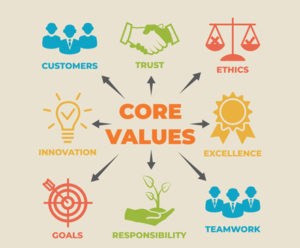 Part of a good marketing plan describes company values along with branding. Do you walk your talk? Do your behaviors support your values or are they lip service to the current fads and trends?
Part of a good marketing plan describes company values along with branding. Do you walk your talk? Do your behaviors support your values or are they lip service to the current fads and trends?
Why is this important? It affects the bottom line. Think about products you won’t buy because of how they are made, how they treat their employees lack of ethics, or more.
Just as with other aspects of the business, it’s time to look at how you are doing and make plans to change what needs to be addressed and change habits.
There are companies that say they support diversity and equity yet they don’t enable their staff to be authentic. Who gets to be themselves at work—and who doesn’t—has become a hot topic. And as companies call employees back to the office and prioritize diversity initiatives, it’s an urgent one. Many firms are focusing—and spending millions—on ensuring physical safety. There is also an imperative to create psychologically safe spaces where workers don’t feel pressure to suppress parts of themselves—to do the corporate code-switch. The pandemic has brought executive leaders to yet another crossroads: Do firms return to the usual environment, which tends toward homogeneity, or strike out on a path that will require a re conceptualization of what it means to be professional?
After last year’s racial protests, corporate America pledged an estimated $60 billion to establish leadership pipeline programs, support entrepreneurs of color, dismantle systematic inequalities, and meet other ambitious goals around diversity, equity, and inclusion (DE&I). The results so far have been mixed, at best. As of spring, only about $250 million had been actually spent or committed to a specific initiative, according to an analysis by the consulting firm Creative Investment Research. Experts say it will take the continued focus of CEOs and boards alike for a long time to ensure that those goals are met. But individual employees can play critical roles along the way. Indeed, workers at any level and from any background can help tackle racism, push for broader equality, and generally create a more inclusive workplace. First, evaluate your non monetary and business reasons for being in the company, and start with your own purpose, why are you there and should you stay there. If the answer is yes what are you willing to do to help the company show it lives up to its values.
There are 5 actions you as an individual, at any level can take:
1. Be inclusive yourself. Too often the focus is on bringing in workers from different backgrounds without making them feel welcome and respected.Greet new employees, invite people to speak up, congratulate them on doing a good job. Make sure they’re involved in the more subtle aspects of work life as well: the happy hours, the business trips, the meetings before the meeting. Ensure that people aren’t being left out. Extend that hand and it goes a long way in making people feel like they belong, Remember people leave companies where they don’t feel they belong.
2. Look for problems yourself.Rather than doing things in response to certain events, actively identify the DE&I gaps in your organization, and figure out what you can personally do to close the gaps. Spend time interacting with your coworkers who are different from you—learn about their experiences and offer help. Develop real relationships.
3. Challenge your own beliefs. Many times, people think people from underrepresented groups can’t do something because they’ve never personally come across such individuals who could. Questioning your existing beliefs and assumptions.and reevaluating is one of the starting points for modern-day inclusion efforts
4.Create or join an employee resource group. Form a non formal employee resource group, or ESG, around common traits, such as race, gender, sexual identity, or even roles and responsibilities at the office. Talking about mutual experiences, sharing success strategies, and problem solving can get the momentum started on improving relationships across an organization, and positively impact retention and engagement
5. Collaborate with management. Talk about process improvements such as enhancing talent acquisition strategy and making the hiring process more inclusive.. A lot of times, employees have great ideas but they don’t know how to get in front of the right people. You need to build allies at multiple levels of the organization to champion any kind of change across an organization
For organizations of every size it’s time to reassess. People are leaving positions or not taking new jobs because they are dissatisfied with their current employer. That includes low wages or noncompetitive benefits, and it also might involve an unfulfilled promise to become a more inclusive organization, or a lack of commitment to developing that worker’s career. Many employees also want their organization to advance social causes and have a greater purpose than just making profit.
Organizations won’t know which of these reasons are most important unless they listen to their employees. Experts suggest leaders do listening tours, town hall meetings, focus groups, and surveys of employees. Talk ‘with’ your employees, not ‘at’ them, learn from them and watch a gradual change take place that will impact all facets of the organization.
Recent Comments